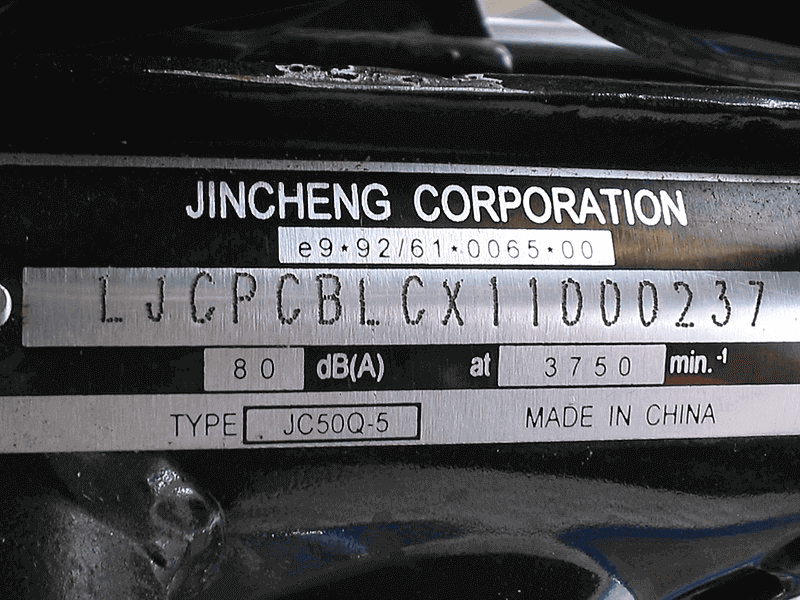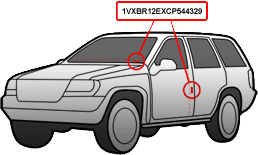FAQ: How to Check VIN Number on a Car?

In North America, VIN numbers consist of 17 digits and can usually be found in these locations:

Each digit in a 17-digit North American VIN number represents a specific piece of information about the vehicle.
The World Manufacturer Identifier (WMI) is the first three digits of a vehicle identification number (VIN) and represents the manufacturer of the vehicle.
1 – Origin – The first digit represents the country or region of the manufacturer.
2 – Manufacturer – The second reveals the manufacturer.
3 – Vehicle type/Make/Division – In some cases, the third digit may represent the specific make or division of the manufacturer as well as the vehicle type.
The Vehicle Descriptor Section (VDS) is the next six digits and provides information about the specific model, trim level, and body style of the vehicle.
4-8 – Attributes – Vehicle attributes such as model, body type, engine type, and transmission type.
9 – Check digit – The ninth digit is a check digit used to verify the authenticity of the VIN.
The Vehicle Identifier Section (VIS) represents the 10th – 17th digits and is unique to each vehicle, providing information about the production plant, serial number, and production date. Together, these three sections provide a comprehensive identification of a specific vehicle.
10 – Model year – This represents the model year.
11 – Factory – The eleventh digit identifies the factory where the vehicle was assembled.
12-17 – Unique serial number – The twelfth to seventeenth digits are the unique serial numbers for the specific vehicle unit.
Collectively, these digits provide a complete history of the vehicle’s production and specifications.
| 1 | United States |
| G | General Motors |
| C | Chevrolet |
| NKPEX | Double Cab/2WD V-6/5-Speed Automatic |
| 0 | Check Digit |
| D | 2013 |
| Z | Roanoke, Indiana |
| 164994 | Unique Serial Number |
| Code | Year | Code | Year | Code | Year | Code | Year | Code | Year | Code | Year |
| A | 1980 | L | 1990 | Y | 2000 | A | 2010 | A | 1980 | L | 1990 |
| B | 1981 | M | 1991 | 1 | 2001 | B | 2011 | B | 1981 | M | 1991 |
| C | 1982 | N | 1992 | 2 | 2002 | C | 2012 | C | 1982 | N | 1992 |
| D | 1983 | P | 1993 | 3 | 2003 | D | 2013 | D | 1983 | P | 1993 |
| E | 1984 | R | 1994 | 4 | 2004 | E | 2014 | E | 1984 | R | 1994 |
| F | 1985 | S | 1995 | 5 | 2005 | F | 2015 | F | 1985 | S | 1995 |
| G | 1986 | T | 1996 | 6 | 2006 | G | 2016 | G | 1986 | T | 1996 |
| H | 1987 | V | 1997 | 7 | 2007 | H | 2017 | H | 1987 | V | 1997 |
| J | 1988 | W | 1998 | 8 | 2008 | J | 2018 | J | 1988 | W | 1998 |
| K | 1989 | X | 1999 | 9 | 2009 | K | 2019 | K | 1989 | X | 1999 |
| WMI | Region | Notes |
| A-C | Africa | AA-AH = South Africa |
| J-R | Asia | J = Japan KL-KR = South Korea L = China MA-ME = India MF-MK = Indonesia ML-MR = Thailand MS = Myanmar NL-NR = Turkey PA-PE = Philippines PL-PR = Malaysia RF-RG = Taiwan |
| S-Z | Europe | SA-SM = United Kingdom SN-ST, W = Germany SU-SZ = Poland TA-TH = Switzerland TJ-TP = Czech Republic TR-TV = Hungary TW-T1 = Portugal VA-VE = Austria VF-VR = France VS-VW = Spain VX-V2 = Yugoslavia XL-XM = The Netherlands XS-XW = USSR X3-X0 = Russia YA-YE = Belgium YF-YK = Finland YS-YW = Sweden ZA-ZR = Italy |
| 1-5 | North America | 1, 4, 5 = United States 2 = Canada 3 = Mexico |
| 6-7 | Oceania | 6A-6W = Australia 7A-7E = New Zealand |
Cars that do not have 17-digit VIN numbers were manufactured before 1981. These vehicles may have VIN numbers ranging from 11 to 13 characters long, depending on the manufacturer. To decode these VIN numbers, the first three characters typically represent the manufacturer and the production location. The next few characters are specific to the model, engine type, and body style. The remaining characters may represent the production year, plant identifier, and serial number. However, decoding these older VIN numbers can be more challenging than decoding modern 17-digit VINs due to variations in formatting and the absence of standardized codes.
If you were doing a background check on vehicles you plan to buy, their VIN codes can be used to generate a vehicle history report by accessing multiple databases that contain information about the car’s past. By analyzing the data compiled in the report, potential buyers and sellers can make informed decisions about the vehicle’s value and condition, and avoid purchasing a lemon or fraudulent car.
The common items found in vehicle history reports by VIN check are the following:
License plate numbers can be used as an alternative to VIN numbers in background checking cars (through a license plate lookup) because license plates are unique identifiers assigned to vehicles by the state, and they can be easily searched using online databases.
The license plate number can provide information on the vehicle’s registration, ownership, history, and current status. This information can be used to verify the vehicle’s identity, detect any fraudulent registration, and assess the risk associated with the vehicle, such as its accident history, mileage, and title status.